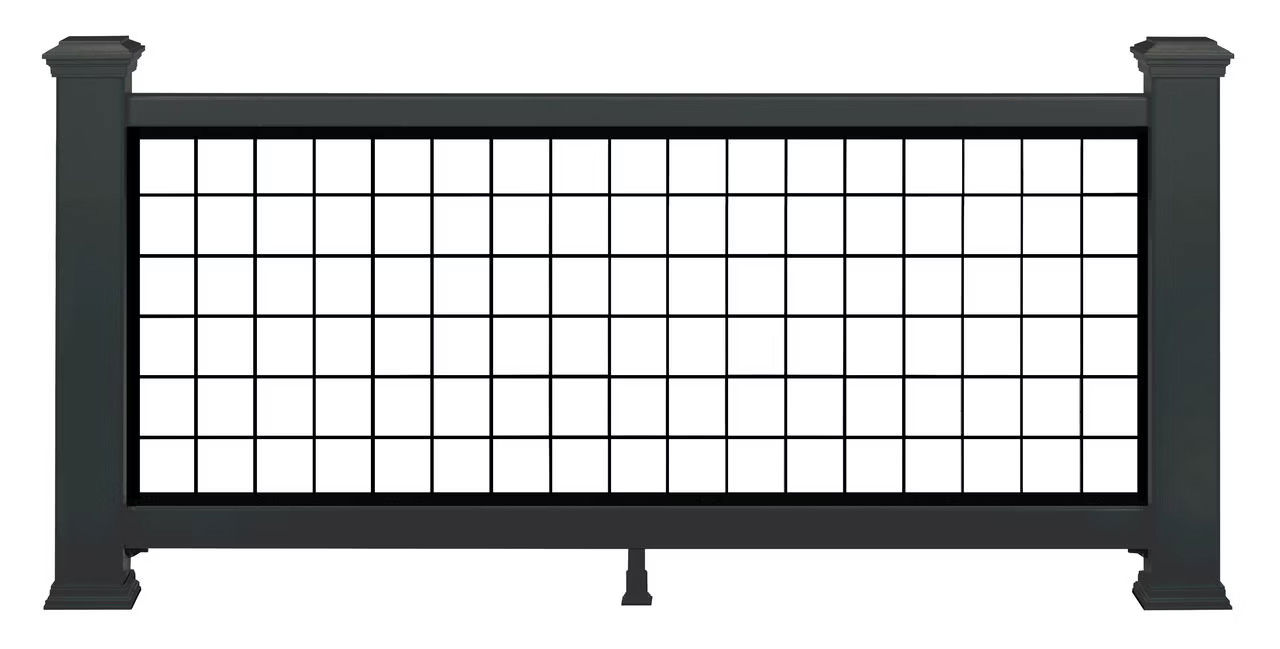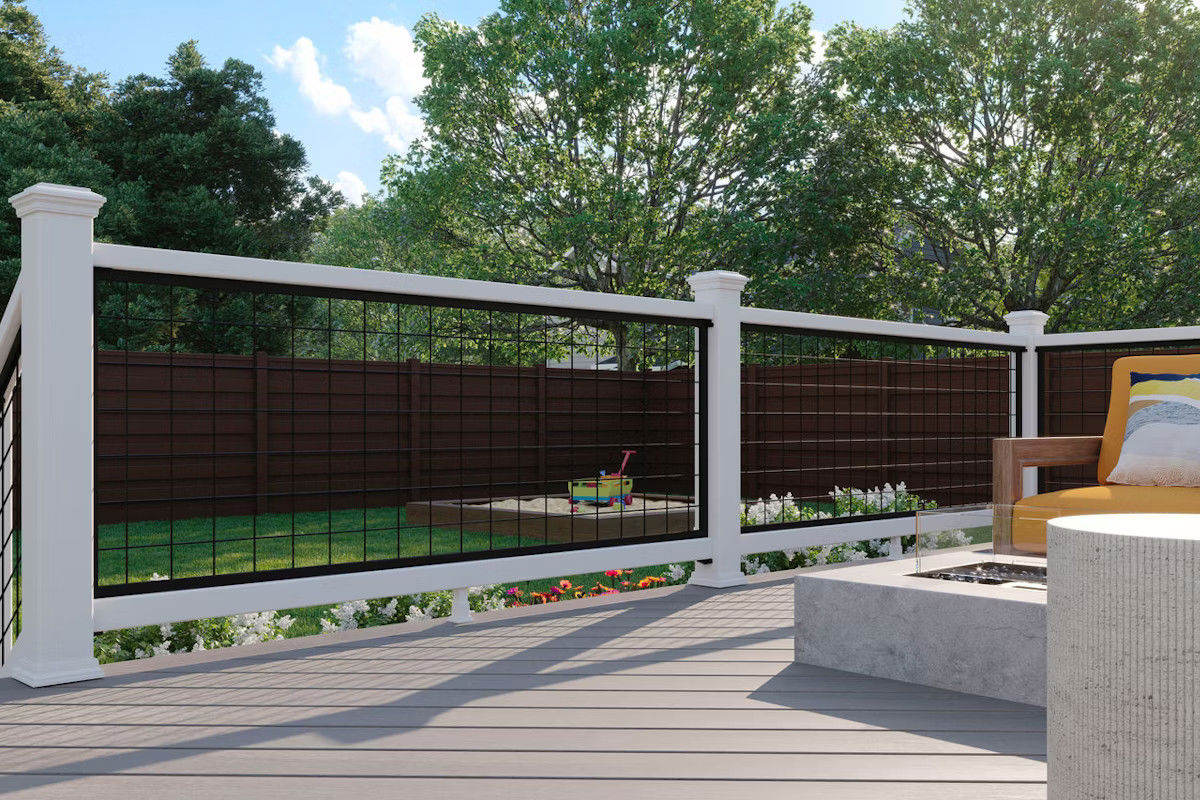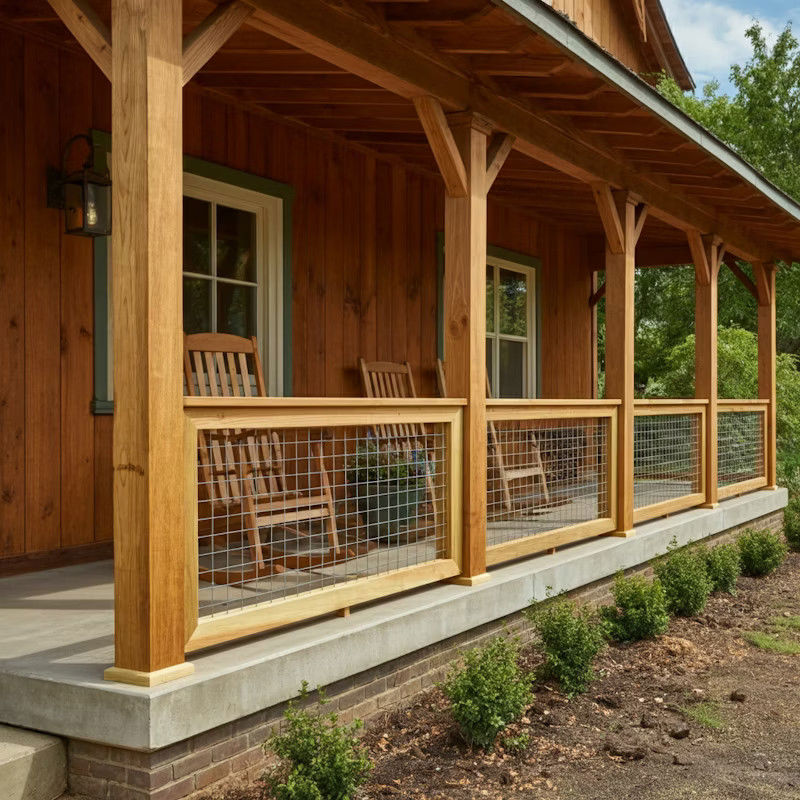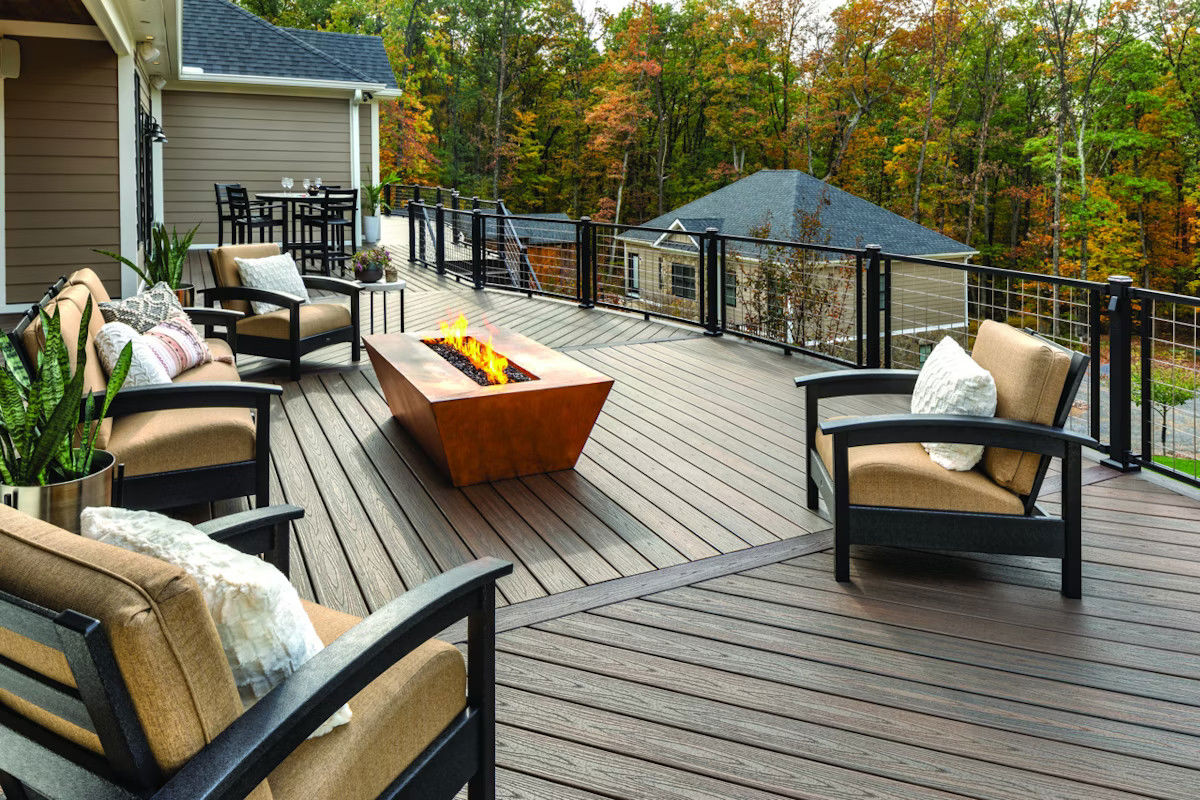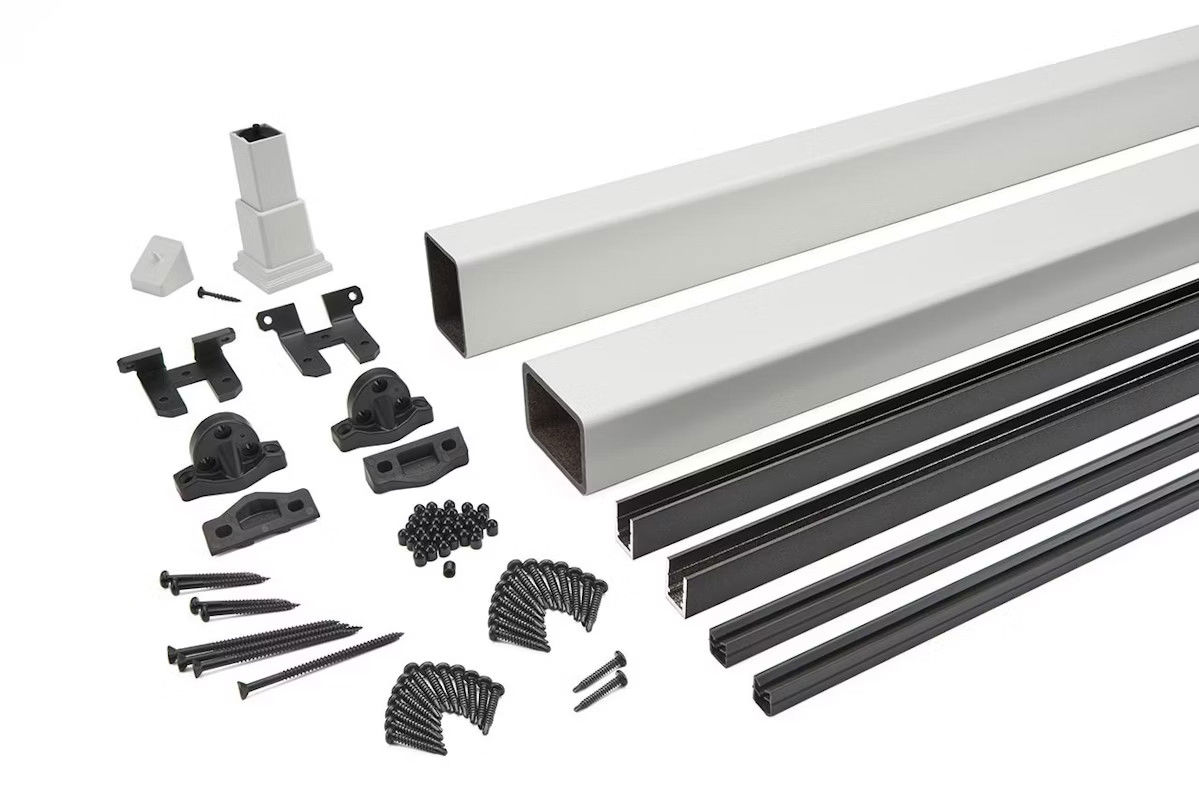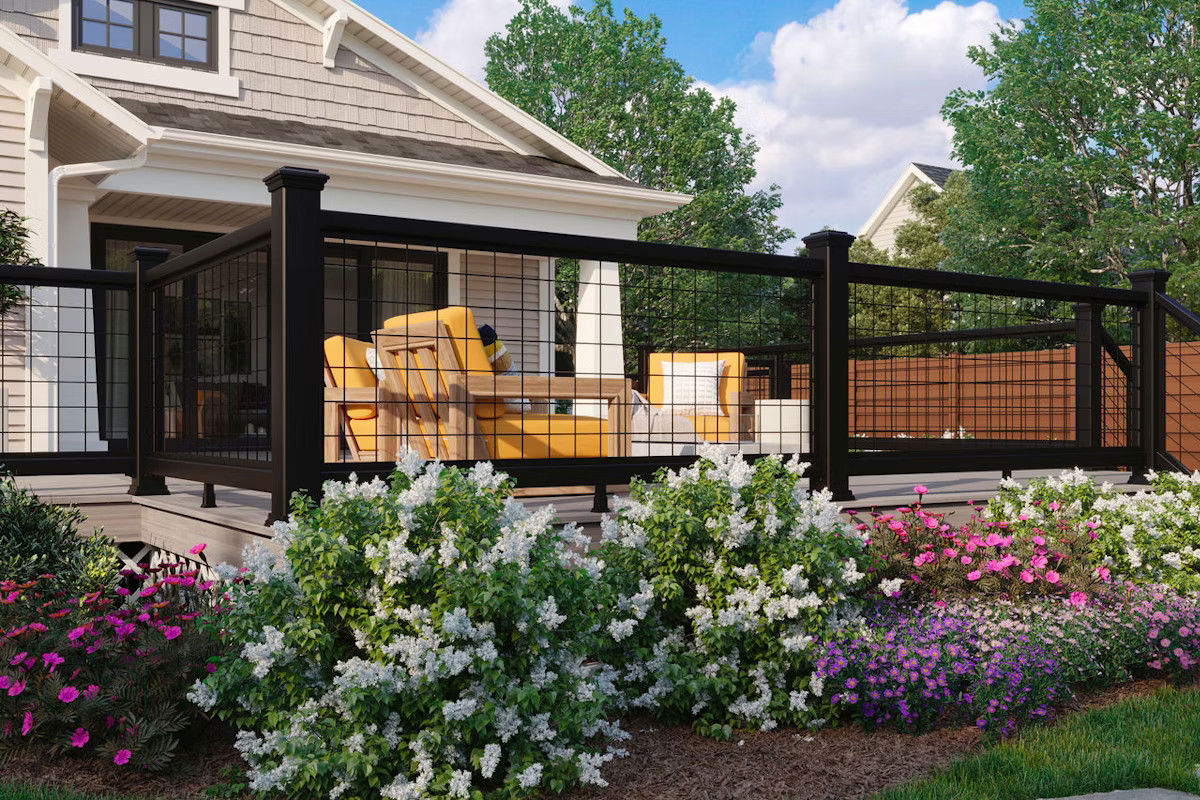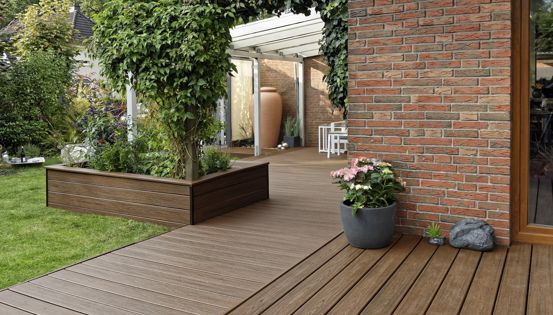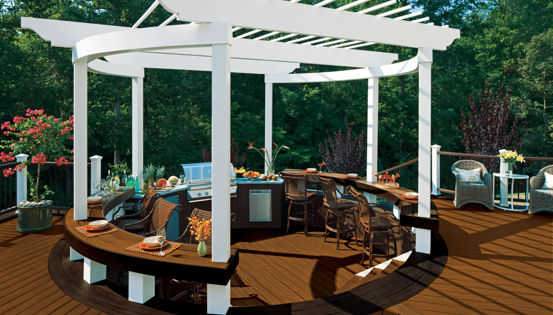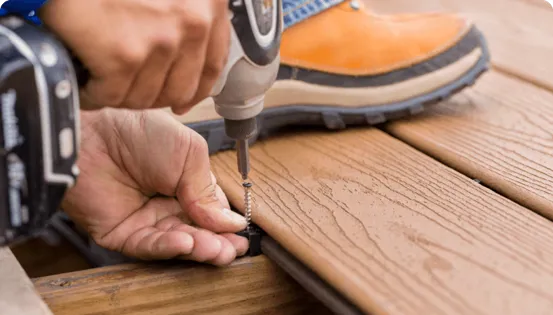Are you upgrading your deck railing or building a new one? Hog wire deck railings are stylish, practical, affordable, and increasingly popular. Their modern yet rustic look complements many home styles, and the mesh offers clear, unobstructed views. This article will explore the benefits, costs, and DIY potential of hog wire railing to help you create a beautiful, functional outdoor space.
What is a Hog Wire Railing?
Instead of traditional balusters, hog wire railings include welded wire mesh panels originally designed for livestock enclosures. Hog wire has since been adapted for residential use, offering a durable, attractive option for deck and porch railings. The hog wire used for railings is thick and sturdy—it’s not the lightweight chicken wire that’s used to keep rabbits out of your garden.
Hog wire mesh can establish a safe guardrail, but the mesh is open enough to create a railing that lets you enjoy the surrounding view and that refreshing summer breeze. To ensure building code compliance, open spaces in hog wire railing typically are less than 4 in. For more information on specific building codes that apply to railings, check out this article.
Choosing the Right Hog Wire Railing for Your Deck
Once you’re sold on hog wire, you have a few decisions to make. You’ll have to choose the type and color of wire panels, and the materials you want to surround and secure the panels. And, you’ll need to decide if you want to tackle this project yourself or hire a pro.
Material Considerations
Stainless steel and aluminum are two of the most expensive, but longest-lasting options. Trex Signature Mesh is one stainless steel option backed by a 50-year warranty. It might be the best choice for coastal areas where it will be exposed to corrosive salt and moisture. To prevent rust, standard steel hog wire is usually protected with a zinc coating process called galvanization.
Galvanized steel is much less expensive than stainless steel. Some agriculture-grade hog wire has only the galvanized coating while some galvanized steel panels have an additional protective coating of paint. Trex Select Mesh is an example of this.
Other standard steel mesh panels are protected with a PVC coating. The metal beneath the PVC coatings should still be galvanized when used as a deck railing infill panel. One disadvantage of PVC coatings is that they can trap water under the coating if the protective surface is penetrated, which can hasten corrosion.
Hog Wire Color Options
Almost all stainless steel and galvanized metal mesh panels are available in a bare metal finish. Powder-coated steel is most often painted black, and PVC coatings are widely available in white and black. You can paint most any hog wire panel a custom color if you’re careful to use premium exterior grade paint designed for metal or PVC.
Combine with Wood, Composite, Steel, or Aluminum Posts and Rails
When it comes to the posts and rails, you have several options. The most expensive combination is stainless steel mesh panels and stainless steel posts and rails. This combination is usually reserved for commercial applications. For a material that has a similar durability of stainless steel, but costs less, choose aluminum posts and rails. Wood posts and rails have a natural look and are the least expensive choice. And finally, composite posts and rails will beautifully tie in with your composite decking.
DIY vs. Professional Installation
A hog wire railing probably shouldn’t be your very first DIY project. However, armed with basic tools and a little patience and planning, a homeowner with moderate carpentry skills can easily do it. Using wood posts and rails, and buying all the panel and necessary hardware separately, will cost less, but a railing kit can greatly simplify installation.
Pros and Cons of Hog Wire Compared with Other Deck Railings
Hog wire railings have become a popular choice for deck designs due to their modern aesthetic and functionality. However, like any option, they come with their own advantages and disadvantages compared to other railing materials like wood, glass, or cable. Understanding these pros and cons can help you decide if a hog wire railing is the right fit for your deck project, style, budget, and maintenance requirements.
Pros:
- Complements a wide variety of architectural styles, from modern to rustic.
- Allows for unobstructed views, making it ideal for scenic locations.
- Offers unobstructed views at a fraction of the cost of cable or glass.
- Basic configurations are easy to install, making it a great option for DIY projects.
- Compatible with wood, aluminum, and composite railing systems.
- Good nonflammable choice in areas where wildfires may be a concern.
- Stainless steel can withstand corrosive effects of salt water.
- Some products are backed by warranties of up to 50 years.
Cons:
- Some metals, such as stainless steel, are expensive.
- Some materials require occasional maintenance to prevent corrosion.
- Does not provide privacy or a wind break.
- The mesh can create a potential climbing risk for small children.
Installation Basics: What to Know About Installing Hog Wire Railings
Installing a hog wire railing is manageable for many homeowners, but proper planning and attention to detail are key for a sturdy, long-lasting result. Whether you're working with a preassembled railing system or gathering and assembling the components yourself, understanding the essential steps will help ensure a smooth installation. Here’s what you need to know:
- Hog wire railings can be a great DIY-friendly option.
- Panels cut to size will need a frame or tracks around the perimeter to add strength and beauty and to shield against sharp edges.
- Mesh can be cut with a metal-cutting saw, grinder, or bolt cutters.
- Wear long sleeves and heavy gloves to avoid injuries from sharp wire.
- Because panels are more difficult to handle than balusters, it’s always better to have two people set them into place.
- Make sure to recoat cut and scratched surfaces of steel with paint, or protect cut ends from corrosion with rubber caps.
- Use exterior-grade hardware and components that can resist the corrosive chemicals used in pressure-treated lumber.
- Whenever possible, plan the location of the posts so that a full panel fits in between them. Full panels look best, and you won’t need to trim them to size or add a frame or tracks around them.
- If you decide to paint your hog wire railing, a paint roller works best. It’s very difficult to avoid paint drips with a brush, and if you use a paint sprayer, most of the paint will sail right past the wire.
- Systems like Trex Select Mesh Railings can offer several installation advantages over railings you build from scratch (more on this below).
- The same building codes governing railing heights and spacing apply to mesh railing systems.
- Always consult your local building official to discuss your plan and obtain any necessary permits.
- When using a system like Trex Select Mesh Panels, keep the instructions on hand. At inspection time, your building official may want to confirm you have followed all the installation instructions.
Advantages of Trex Select Mesh Railing
Trex Select Mesh Panels offer several advantages over other hog wire railing systems. For starters, Trex values its reputation as a manufacturer of only premium decking products, and the Select Mesh Panels are no exception. Here are more benefits:
- Long Lasting: Trex Select Mesh Panels are sturdy, durable, moisture resistant, and of course, rot and burrowing pests like termites are never a concern with metal railings.
- Low Maintenance: Given the thickness of the metal and the quality of the powder-coated paint, Trex is confident in providing a 15-year warranty, even in the wettest climates. When installed in drier areas like the southwest regions of the U.S., Trex Select Mesh Panels can deliver decades of high performance with minimal upkeep.
- Design Flexibility: Trex Select Mesh Panels can be integrated into a wood railing system for a rustic aesthetic, or combined with Trex Select Composite Posts and Rails or Select Aluminum Post Sleeves.
- Ease of Installation: Unlike cobbled-together hog wire systems, a Trex mesh railing system is engineered to be DIY friendly. It can reduce the number of cuts required, and removes any guesswork about hardware types and quantities.
- Confidence: Choosing any product from an industry leader and pioneer like Trex will give you the confidence to know you are investing in proven performance, lasting beauty, and unmatched durability backed by decades of innovation and trust.
Explore More About Trex and Decking Solutions
Looking to learn more about Trex products or decking tips? We’ve compiled a list of helpful articles and resources available on Trex.com and Decks.com. These guides provide additional insights, inspiration, and practical advice for your outdoor projects:
- Deck Design Ideas – Explore a wide range of deck design ideas to spark creativity and find the perfect look for your space.
- How to Install Deck Railings – Step-by-step guidance on installing deck railings, ensuring safety and adherence to building codes.
- Selecting the Right Decking Material – Learn about different decking materials and choose the best option for your outdoor project.
- Deck Maintenance Tips – Practical advice on how to maintain your deck for long-lasting beauty

